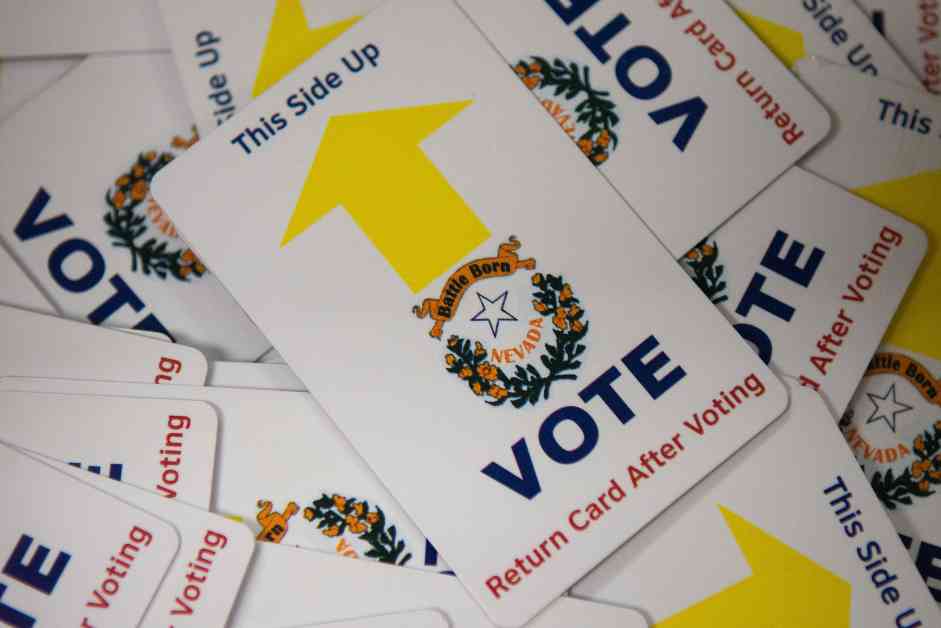Nevada is on the brink of potentially implementing significant changes to its election system, as voters will have the opportunity to vote on a ballot measure that could revolutionize the way elections are conducted in the state. If passed, Nevada would become the third state in the country to implement statewide ranked-choice voting, following in the footsteps of Maine and Alaska.
The measure at hand, known as Question 3, seeks to amend the Nevada Constitution in two major ways. Firstly, it aims to allow all voters to participate in primaries regardless of their party affiliation. Secondly, it aims to implement ranked-choice voting in general elections. This proposed change has the potential to reshape the landscape of Nevada politics and empower voters in a new and innovative way.
Question 3 has been presented to voters for the second time, after narrowly passing in the 2022 election. It has sparked significant debate and garnered both support and opposition from various stakeholders. Let’s delve deeper into the specifics of what Question 3 entails, who stands behind it, and the potential implications it could have on the state’s electoral process.
### The Impact of Question 3 on Nevada’s Election System
Question 3 would fundamentally alter the way partisan elections are conducted in Nevada. It would require most partisan elections in the state to transition to a ranked-choice voting system, with the exclusion of presidential and local government elections. This change would affect contests for U.S. Senate and congressional races, legislative elections, and statewide office positions.
Under the proposed system, primary elections in Nevada would open up to all voters, irrespective of their party registration, starting in 2026. The top five vote-getters, regardless of their political affiliation, would advance to the general election. This shift from a closed primary system, where only registered voters of the same political party can participate, could democratize the electoral process and allow for a more inclusive representation of the electorate.
At the general election, voters would rank candidates by order of preference, with the option to mark as many as five preferences among candidates. If a candidate receives a majority of the votes (more than 50 percent), they would be declared the winner. However, if no candidate secures a majority, the candidate with the fewest first-preference votes would be eliminated, and their votes would be redistributed to the candidates listed as voters’ second preference. This iterative process would continue until a candidate reaches a majority.
Votes for “none of these candidates” would be calculated and reported but would not be counted towards electing or ranking any candidates for partisan office. The proposed system aims to provide voters with more choices and ensure that the candidate who ultimately wins has broad-based support among the electorate.
### The Journey of Question 3 and Its Supporters
The ballot question, formally known as the Better Voting Nevada Initiative, began its journey in November 2021 when Nevada Voters First, a political action committee, filed the initiative petition seeking a constitutional amendment to enact the proposed election changes. The Institute for Political Innovation, a nonprofit founded by author and philanthropist Katherine M. Gehl, provided financial backing for the measure.
Gehl, who pioneered the concept of “final-five voting,” which is at the core of Question 3, has been a driving force behind the initiative. Despite facing legal challenges, the measure passed in November 2022 with the support of approximately 53 percent of voters, indicating a significant level of public interest and engagement with the proposed reforms.
In a bid to amplify their campaign efforts, organizers of the initiative registered a new PAC, Vote Yes on 3, Inc., signaling a renewed push to garner support for the measure. The backing of prominent individuals and organizations, along with grassroots efforts, has been instrumental in advocating for the adoption of ranked-choice voting in Nevada.
### Lessons from Other States: Maine and Alaska’s Experience with Ranked-Choice Voting
Maine and Alaska stand as trailblazers in the realm of ranked-choice voting, having adopted the system for statewide elections. In 2016, Maine voters approved ranked-choice voting for state and federal primary elections and general congressional elections, implementing it in 2018. The state further expanded the use of ranked-choice voting to presidential general elections in 2020 and presidential primaries starting in 2024.
Similarly, voters in Alaska embraced ranked-choice voting in 2020, with the system being utilized in all state and federal general elections from 2022 onwards. The experiences of these states offer valuable insights into the practical implications and challenges associated with implementing ranked-choice voting on a broader scale.
Beyond Maine and Alaska, several municipalities, including New York City, have also adopted ranked-choice voting, indicating a growing interest in exploring alternative electoral systems that prioritize voter choice and representation. The success of ranked-choice voting in these jurisdictions serves as a testament to the potential benefits of embracing innovative approaches to democracy.
### The Arguments For and Against Question 3: Perspectives from Advocates and Opponents
Supporters of Question 3 argue that the proposed changes would enhance the inclusivity of the electoral process and empower voters to have a greater say in determining the outcome of elections. With nonpartisans outnumbering registered Democrats and Republicans in Nevada since 2023, advocates contend that opening up primaries to all voters could mitigate the influence of extreme candidates and provide a platform for candidates with broader appeal to advance to the general elections.
A’Esha Goins, the founder of Black Joy Consulting and outreach director for the Yes on 3 campaign, emphasized the transformative potential of Question 3 in eliminating the need to choose the “lesser of two evils” in general elections. By enabling voters to rank candidates based on their preferences, the proposed system aims to foster a more representative and responsive political landscape.
On the other hand, opponents of Question 3, including Nevada’s Democratic senators and other elected officials, have raised concerns about the complexity of ranked-choice voting and the potential for errors that could disenfranchise voters. Critics argue that the implementation of ranked-choice voting could lead to confusion among voters and pose challenges in ensuring the accuracy and integrity of the electoral process.
The Let Nevadans Vote coalition, comprising over 20 groups, has voiced reservations about the initiative, highlighting potential barriers to voter participation and comprehension. The Nevada State AFL-CIO has also expressed opposition to the measure, underscoring the need for a thorough evaluation of the implications of transitioning to a ranked-choice voting system.
### Financing and Fiscal Implications of Question 3
The financial impact of implementing ranked-choice voting in Nevada has been a topic of scrutiny and analysis. A financial analysis conducted by the Legislative Counsel Bureau fiscal staff in 2022 estimated that the transition to ranked-choice voting would cost approximately $3.2 million ahead of the 2026 general election, with an additional $57,000 per year for ongoing expenses.
The projected costs encompass various aspects, including voter outreach and education, increased ballot stock costs, personnel expenses, equipment, software, and programming costs for voting machines, and updates to training materials. As Nevada prepares to embark on this transformative journey in its electoral system, careful consideration of the financial implications is crucial to ensuring a smooth and effective transition.
### Conclusion
The prospect of implementing ranked-choice voting in Nevada represents a significant step towards enhancing the democratic process and fostering greater voter engagement. By embracing innovative approaches to elections, Nevada has the opportunity to redefine its political landscape and empower its citizens to play a more active role in shaping the future of the state.
As voters consider the implications of Question 3 and weigh the arguments put forth by supporters and opponents, it is essential to prioritize transparency, accessibility, and accountability in the electoral process. The lessons learned from other states that have adopted ranked-choice voting can serve as a valuable guide for Nevada as it navigates this transformative journey towards a more inclusive and representative democracy.



